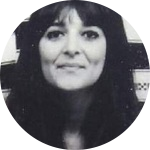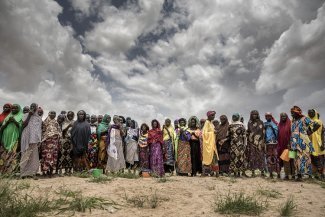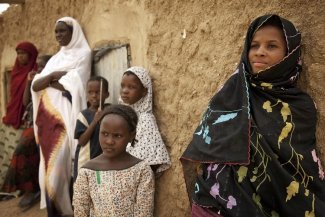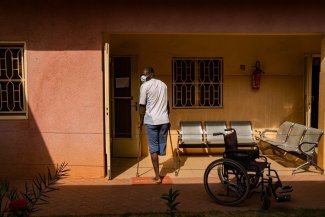Young people at the Mbera Connectivity Centre, where they learn IT skills.
In south-east Mauritania, just 50 kilometres from the border with Mali, lies the Mbera refugee camp. In 2012, when the war in Mali began, thousands of people fled to neighbouring Mauritania in search of the safety their country could not provide. A decade later, refugees are still arriving at the camp. Although the war officially ended years ago, ongoing terrorist activity in the region is forcing thousands of people to flee to neighbouring countries every year, to live in peace.
Despite being one of the poorest countries in the world, Mauritania is host to 89,790 refugees and 4,541 asylum seekers, 79,656 of whom are living in the Mbera camp, according to UNHCR data from July 2022. This makes it one of the largest refugee camps in West Africa and the second in terms of the number of Malian refugees hosted.
A large share of the people living in the Mbera camp are minors: an estimated 40,000 are under 18 years of age and most of them are of school age (around 34,000). But only some 30 per cent of the youngest children attend primary school and an even lower percentage (in the 12-17 age group) attend secondary school. According to UNHCR data, by the 2020-2021 school year, only around 5,570 children were in primary school and 410 in secondary school (figures only marginally affected by the coronavirus pandemic).
Although refugee children are consistently less likely to be in school than other children (the global rate of refugee children in school in 2020 was 77 per cent in primary education, and less than 32 per cent in secondary), in Mbera, the rate is abysmal, and among the lowest in the world.
For girls, the inequality is striking: only three out of ten school pupils are girls.
Refugee children have the option, in theory, to be educated in the camp or integrated into the Mauritanian school system, thanks to a recent government measure authorising this possibility. The schools in the refugee camp, set up by UNHCR and UNICEF, follow the curriculum of Mali, where schooling is in French but, to facilitate their integration in the host country, Arabic is also taught.
Vulnerability and insufficient human and material resources
Enrolment rates are low among children and adolescents in the Mbera camp due to both a lack of infrastructure and a shortage of human resources: there are only eight schools and a shortage of teachers. “If all the [potential] pupils showed up for school, we would not be able to accommodate them,” sums up Apollinaire Gerard, project manager of the Connectivity Centre. A large part of the teaching staff is, moreover, made up of refugees themselves and only 23 per cent of teachers have the qualifications officially recognised by the Malian government. This also affects the quality of the teaching, according to a study provided to Equal Times by Save the Children Spain.
And given the level of poverty and vulnerability in the camp, for many families, sending their children to school is not a priority.
When children finish primary school, or even before, they start helping their families, either by working or by doing household chores (in the case of girls). “Many families are cattle herders and travel with their cattle to different villages where there are pastures. Although they are registered in the camp, the herders travel with their children, which makes schooling difficult,” explains Gerard.
Girls tend to drop out of school earlier than boys, as parents often prioritise the education of boys if they cannot afford to send all their children to school. The frequent child marriages and early pregnancies are another reason for girls having to abandon their education prematurely.
Koranic schools, or madrassas, occupy an important place in Muslim culture in the region. Children between the ages of five and eight attend these schools to learn the Koran. Some madrassas also teach Arabic and mathematics. This education system is deemed to be sufficient by many Muslim families, who do not see any benefit in sending their children to formal schools. As a result, many children do not enter primary school until they have finished Koranic school or are not enrolled at the UN-run schools in the camp. The problem with madrassas is that most of them only teach the Koran. If the children do not learn French, which is the administrative language in Mali, it curtails their chances of integrating into the school system in their (or their parents’) country of origin and, later on, finding jobs that require a high level of qualification.
To improve children’s health and the rate of school enrolment, NGOs such as Save the Children are funding school canteens offering pupils one meal a day. The idea is to encourage parents to send their children to school more regularly. The increase in food prices since the end of 2021 has led to a 44 per cent rise in certain basic foodstuffs, such as oil, according to the Famine Early Warning Systems Network. And the most vulnerable families are finding it increasingly difficult to feed their children as a result.
They also find it increasingly difficult to pay for school materials. This was even more marked during the pandemic. The outbreak of Covid-19 meant that courses had to be improvised through radio or social media, but less than 20 per cent of households in the Mbera camp had a radio, television or a smartphone with internet access.
Online courses and technologies, a passport to the future
In terms of education, it is mainly UNHCR and UNICEF that set up and manage the schools in the camp. Together with Save the Children Spain, these two organisations have set up a computer centre called the Connectivity Centre, which provides refugees with access to the internet and training in new information and communication technologies (ICTs).
The Connectivity Centre is a large room with computers and free internet access that enables young people, and adults, to access the outside world and online learning. Save the Children, together with UNHCR and UNICEF, is also training teachers, literacy facilitators and education advisors in the use of technology in education. A hundred secondary school pupils receive IT classes every week at the centre. This gives them access to a computer and 3G in a context where computers and smartphones are a rarity and power cuts and the inability to afford internet access are the norm. The young people living in these circumstances have a keen interest in technology and the internet and visit the centre on a regular basis. They know that being ICT literate will improve their CVs and broaden their job opportunities.
“Thanks to this centre, I have discovered the world of IT. I didn’t even know how to turn on a computer before. Now I can search for information, prepare my classes and do training. I have obtained a number of certificates, through international online courses, on subjects such as human rights or migration,” says Mohamed Ali Ag Mohamedoun, a French and history teacher at the Mbera camp.
The centre also encourages people to take the free online courses offered by various organisations. In an area where there are no universities and the nearest one is several days’ drive away, being able to access university education free of charge is an invaluable learning opportunity for these youngsters.
They are able, for example, to access platforms such as the US-based Coursera, which offers free courses from the world’s leading universities, allowing them to study remotely, from the refugee camp, and build a better future for themselves.
“I have 13 certificates, some of them related to the world of work and other subjects such as water policy management, humanitarian law or development. I am convinced that the Connectivity Centre is a life-saving opportunity for us refugees,” says Mohamed Issa Ag Oumar.
“Some young people have never seen a computer,” says Gerard. Young people from the nearest village, Bassikounou, some 20 kilometres from the refugee camp, also travel to the centre to have access to a computer and the internet. In the two years since the Connectivity Centre has been open, hundreds of people in the refugee camp have been able to learn IT skills and access the internet. The success is such that several institutions are studying the possibility of opening another Connectivity Centre in the town of Bassikounou, to provide the Mauritanian population with similar access and opportunities.













